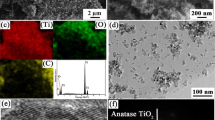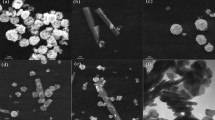Abstract
Two dimensional (2D) CuTCPP/B–TiO2 composites were successfully synthesized by addition of B–TiO2NPs into the system for preparation of 2D CuTCPP nanosheets under hydrothermal condition. 2D CuTCPP nanosheets with large specific surface area can not only act as supportor to decrease the aggregation of B–TiO2 and improve the adsorption capacity of methylene blue (MB) but also provide more transfer pathway to effectively facilitate interfacial charge transfer and separation of photogenerated electrons and holes, thus leading to a superior efficiency for photodegradation of MB. The photocatalytic degradation rate constant of 2D CuTCPP/B–TiO2 composites is 0.0486 min−1, which is about 15.2, 5.92 and 4.23 times that of P25 (k = 0.0032 min−1), 2D CuTCPP nanosheets ((k = 0.0082 min−1) and B–TiO2NPs (k = 0.0115 min−1). This study demonstrates that the combination of B–TiO2NPs and 2D CuTCPP is a viable strategy to improve the photocatalytic efficiency for degradation of MB.










Similar content being viewed by others
Data and code availability
The datasets used and analyzed during the current study are available from the corresponding author on reasonable request.
References
Salazar R, Brillas E, Sirés I (2012) Finding the best Fe2+/Cu2+ combination for the solar photoelectro-fenton treatment of simulated wastewater containing the industrial textile dye disperse blue 3. Appl Catal B Environ 116:107–116
Rafiq A, Ikram M, Ali S (2021) Photocatalytic degradation of dyes using semiconductor photocatalysts to clean industrial water pollution. J Ind Eng Chem 97:111–128
Crini G (2006) Non-conventional low-cost adsorbents for dye removal: a review. Bioresour Technol 97:1061–1085
Shen K, Cui Y, Zhang D (2020) Biomimetic preparation of MoS2–Fe3O4 MNPs as heterogeneous catalysts for the degradation of methylene blue. J Environ Chem Engin 8:104125
Zhao Y, Dong Y, Lu F (2017) Coordinative integration of a metal-porphyrinic framework and TiO2 nanoparticles for the formation of composite photocatalysts with enhanced visible-light-driven photocatalytic activities. J Mater Chem 5:15380–15389
Dong H, Zeng G, Tang L (2015) An overview on limitations of TiO2-based particles for photocatalytic degradation of organic pollutants and the corresponding countermeasures. Water Res 79:128–146
Lin Y, Li D, Hu J (2012) Highly efficient photocatalytic degradation of organic pollutants by PANI-modified TiO2 composite. J Phys Chem C 116:5764–5772
Goetz V, Cambon J, Sacco D (2009) Modeling aqueous heterogeneous photocatalytic degradation of organic pollutants with immobilized TiO2. Chem Eng Process 48:532–537
Du X, Wu Y, Kou Y (2019) Amorphous carbon inhibited TiO2 phase transition in aqueous solution and its application in photocatalytic degradation of organic dye. J Alloys Compd 810:151917
Touchente Z, Simsek S, Boufi S (2019) Ultrasonic effect on the photocatalytic degradation of rhodamine 6G (Rh6G) dye by cotton fabrics loaded with TiO2. Cellulose 27:1085–1097
Ren L, Zhou W, Sun B (2019) Defects engineering of magneticγ-Fe2O3 ultrathin nanosheets/mesoporous black TiO2 hollow sphere heterojunctions for efficient charge separation and the solar-driven photocatalytic mechanism of tetracycline degradation. Appl Catal B Environ 240:319–328
Yang Z, Guo Z, Zhang J (2021) The development and application of metal-organic frameworks in the field of photocatalysis. Res Chem Intermediat 47:325–343
Spanopoulos I, Tsangarakis C, Klontzas E (2016) Reticular synthesis of HKUST-like tbo-MOFs with enhanced CH4 storage. J Am Chem Soc 138:1568–1574
Yuan Y, Yin L, Cao S (2015) Improving photocatalytic hydrogen production of metal-organic framework UiO-66 octahedrons by dyesensitization. Appl Catal B Environ 168:572–576
Chen D, Wang K, Hong W (2015) Visible light photoactivity enhancement via CuTCPP hybridized g-C3N4 nanocomposite. Appl Catal B Environ 166:366–373
Lee C, She C, Jeong NC (2010) Porphyrin sensitized solar cells: TiO2 sensitization with a piextended porphyrin possessing two anchoring groups. Chem Commun 46:6090–6092
Chen D, Yang D, Geng J (2008) Improving visible-light photocatalytic activity of N-doped TiO2 nanoparticles via sensitization by Zn porphyrin. Appl Surf Sci 255:2879–2884
Zhang Z, Liu H, Xu J (2017) CuTCPP/BiPO4 composite with enhanced visible light absorption and charge separation. J Photochnol Photobiol A 336:25–31
Zhang Z, Huang H, Sun S (2018) CuTCPP hybridized Bi2MoO6 composite with enhanced photocatalytic activity. J Porphyr Phthalocya 22:469–474
Chen E, Qiu M, Zhang Y (2017) Acid and base resistant zirconium polyphenolate-metallopor yrin scaffolds for efficient CO2 photoreduction. Adv Mater 30:170438
Zhang H (2016) Efficient visible-light-driven carbon dioxide reduction by a single-atom implanted metal-organic framework. Angew Chem Int Ed 55:14310–14314
Zhao L, Zhao Y, Li R (2020) Insights into the binding mechanism of 2D copper-tetrakis -(4-carboxyphenyl)-porphyrin metal-organic framework nanosheets with rhodamine B: spectroscopic and thermodynamics studies. Chem Phys 534:110743
Zhao M, Wang Y, Ma Q (2015) Bioinspired design of ultrathin 2D bimetallic metal-organic-framework nanosheets used as biomimetic enzymes. Adv Mater 27:7372–7378
Wang P, Wang J, Wang X (2013) One-step synthesis of easy-recycling TiO2–rGO nanocomposite photocatalysts with enhanced photocatalytic activity. Appl Catal B Environ 133:452–459
Rahimi R, Shariatinia S, Zargari S (2015) Synthesis, characterization, and photocurrent generation of a new nanocomposite based Cu–TCPP MOF and ZnO nanorod. RSC Adv 5:46624–46631
Cui S, Qian M, Liu X (2015) A copper porphyrin-based conjugated mesoporous polymer-derived bifunctional electrocatalyst for hydrogen and oxygen evolution. Chemsuschem 9:2365–2373
Wang J, Wu L, Li J (2018) Simultaneous and effificient removal of fluoride and phosphate by Fe–La composite: adsorption kinetics and mechanism. J Alloys Compd 753:422–432
Gao Q, Zhang X, Yin W (2018) Functionalized MoS2 nanovehicle with near-infrared laser-mediated nitric oxide release and photothermal activities for advanced bacteria-infected wound therapy. Small 14:1802290–1802303
Zhao M, Wang Y, Ma Q (2016) Ultrathin 2D metal-organic framework nanosheets. Adv Mater 27:7372–7378
Guo Y, Gao B, Deng Z (2021) Charge separation in hybrid metalorganic framework films for enhanced catalytic CO2 conversion. J Mater Chem A 9:2694–2699
Sun L, Xie J, Li Q (2019) Facile synthesis of thin black TiO2−X nanosheets with enhanced lithium-storage capacity and visible light photocatalytic hydrogen production. J Solid State Electrochem 23:803–810
Wang M, Zheng D, Ye M (2015) One-dimensional densely aligned perovskite-decorated semiconductor heterojunctions with enhanced photocatalytic activity. Small 11:1436–1442
Cao J, He J, Ye J (2021) Urchin-like Bi2S3/Ag nanostructures for photocatalytic reduction of Cr(VI). ACS Appl Nano Mater 4:1260–1269
Xu Y, Liu Z, Zhang X (2009) A Graphene hybrid material covalently functionalized with porphyrin: synthesis and optical limiting property. Adv Mater 21:1275–1279
Zhao Y, Jiang L, Mi L (2018) Synthesis of porphyrin-based two-dimensional metal-organic framework nanodisk with small size and few layers. J Mater Chem A 6:2828–2833
Wei S, Wu R, Xu X (2016) One-step synthetic approach for core-shelled black anatase titania with high visible light photocatalytic performance. Chem Eng J 299:120–125
Cheng X, Liu H, Chen Q (2014) Preparation of graphene film decorated TiO2 nano-tube array photoelectrode and its enhanced visible light photocatalytic mechanism. Carbon 66:450–458
Yang Y, Xu L, Wang H (2016) TiO2-graphene porous composite and its photocatalytic degradation of methylene blue. Mater Des 108:632–639
Zhang J, Xu L, Zhu Z (2015) Synthesis and properties of (Yb, N)–TiO2 photocatalyst for degradation of methylene blue (MB) under visible light irradiation. Mater Res Bull 70:358–364
Zhang J, Yuan W, Xia T (2015) A TiO2 coated carbon aerogel derived from bamboo pulp fibers for enhanced visible light photo-catalytic degradation of methylene blue. Nanomaterials 11:239
Mutalib M, Aziz F, Jamaludin N (2018) Enhancement in photocatalytic degradation of methylene blue by LaFeO3–GO integrated photocatalyst-adsorbents under visible light irradiation. Korean J Chem Eng 35:548–556
Zhao G, Zhang D, Huang Y (2018) Highly efficient degradation of 2-chlorophenol and methylene blue with Rb0.27WO3/NiFe–CLDH composites under visible light irradiation. Adv Powder Technol 29:2491–2500
Author information
Authors and Affiliations
Corresponding authors
Ethics declarations
Conflict of interest
The authors state that there are no conflicts of interest to disclose.
Ethical approval
This work does not involve the use of any human participants or animals.
Supplementary information
The supplementary information was put into the supplementary document.
Additional information
Handling Editor: Dale Huber.
Publisher's Note
Springer Nature remains neutral with regard to jurisdictional claims in published maps and institutional affiliations.
Supplementary Information
Below is the link to the electronic supplementary material.
Rights and permissions
Springer Nature or its licensor (e.g. a society or other partner) holds exclusive rights to this article under a publishing agreement with the author(s) or other rightsholder(s); author self-archiving of the accepted manuscript version of this article is solely governed by the terms of such publishing agreement and applicable law.
About this article
Cite this article
Yang, Y., Lu, J., Ma, Z. et al. Photocatalytic degradation of methylene blue over 2D CuTCPP/B–TiO2 composites. J Mater Sci 58, 7571–7582 (2023). https://doi.org/10.1007/s10853-023-08505-4
Received:
Accepted:
Published:
Issue Date:
DOI: https://doi.org/10.1007/s10853-023-08505-4




